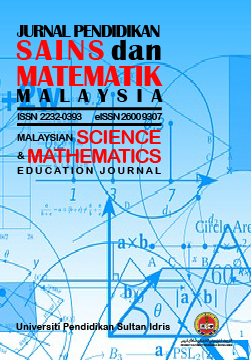Effect of Using Flow Map Towards Mathematical Achievement and Thinking Skills Among Year Three Students
Kesan Penggunaan Peta Alir terhadap Pencapaian Matematik dan Kemahiran Berfikir Murid Tahun Tiga
DOI:
https://doi.org/10.37134/jpsmm.vol12.1.9.2022Keywords:
Mathematical Problem Solving, Flow Map Method, Higher Order Thinking Skills Mathematics Education, Mathematic Teaching TechniqueAbstract
This study aimed to test the effect of flow charts on math achievement and thinking skills of third year students. A quasi -experimental design of unequal groups was used. A quasi - experimental quantitative approach of unequal groups was used in this study. The selection of study participants was done by group random sampling to involve 60 third year students in a national school in Petaling District, Selangor. Respondents were divided into two groups, namely 30 students in the treatment group and 30 students in the control group. The study used two main instruments, namely the mathematical achievement test and the high -level thinking skills test. Data were analysed using t-test to see the mean difference. The findings showed that there were significant differences of post-test between the control group and the treatment group. The findings show that the flow chart method has a positive effect on the mathematical achievement test and the critical thinking skills test. In conclusion, the flow chart method can be used as an alternative method for students and teachers to solve sentence -length mathematical problem-solving questions. It is hoped that this study can be used as a reference and give implications to teachers' teaching methods. It is also hoped that this will support the efforts of the Ministry of Education Malaysia in achieving the aspirations of students.
Downloads
References
Abdullah, M.Z., Daud, I., Idris, M.R., & Rahman, M.N.A. (2019). Kesan pembelajaran flipped classroom terhadap sikap bagi penyelesaian masalah bagi algebra, Jurnal Kurikulum & Pengajaran Asia Pasifik, 7(4), 1–10. Diperolehi dari https://juku.um.edu.my/
Ariffin, N.E., & Aziz, N.H.A. (2016). Persepsi murid tahun lima terhadap penggunaan kaedah model bar dalam penyelesaian masalah matematik berayat tajuk pecahan. International Seminar on Generating Knowledge Through Research. Universiti Utara Malaysia.
Avvisati, F., Echazarra, A., Givord, P., & Schwabe, M. (2019). The programme for international student. Diperolehi dari https://www.oecd.org/pisa/publications/PISA2018_CN_IDN.pdf
Bahagian Pembangunan Kurikulum. (2012). Buku Panduan Program I-Think. Putrajaya: Kementerian Pendidikan Malaysia.
Bachri, B.S. & Nurdyansyah. (2017). Problem solving model with integration pattern: student’s problem-solving capability, Education and Humanities Research. Diperolehi dari file:///C:/Users/hp/Downloads/Problem_Solving_Model_with_Integration_Pat tern_Stu.pdf
Gurat, M.G. (2018). Mathematical Problem-Solving Strategies Among Student Teachers. Journal on Efficiency and Responsibility in Education and Science. Diperolehi dari https://files.eric.ed.gov/fulltext/EJ1208772.pdf
Hassan, N.H., Hussin, Z., Siraj, S., Sapar, A.A., & Ismail, Z. (2019). Kemahiran berfikir kritis dalam buku teks bahasa melayu kurikulum standard sekolah rendah tahap II. Jurnal Kurikulum & Pengajaran Asia Pasifik, 7(1), 18–29. Diperolehi dari https://ejournal.um.edu.my/
Ismail, F., Nasir, A.A., Haron, R., & Kelewon, N.A. (2020). Mendominasi kemahiran penyelesaian masalah secara kritis melalui penglibatan mahasiswa dalam kokurikulum bulan sabit merah Malaysia. Research in Management of Technology and Business. Diperolehi dari https://publisher.uthm.edu.my/
Kementerian Pendidikan Malaysia. (2018). Dokumen Standard Kurikulum Dan Pentaksiran Matematik Tahun 4. Putrajaya: Bahagian Pembangunan Kurikulum.
Kementerian Pendidikan Malaysia. (2012). Laporan Awal-Ringkasan Eksekutif. Pelan Pembangunan Pendidikan Malaysia 2013-2025. Putrajaya
Moyer (2015). Effects of virtual manipulatives on student achievement and mathematics learning. International Journal of Virtual and Personal Learning Environments, Diperolehi dari http://dx.doi.org/10.4018/jvple.2013070103
Muhamad, N., Zakaria, M.A., Salleh, S.M. & Harun, J. (2018). Penggunaan permainan digital dalam pembelajaran bilik darjah bagi meningkatkan kreativiti dalam penyelesaian masalah matematik. Fakulti Sains Sosial dan Kemanusian. Universiti Teknologi Malaysia.
Noor Hidayah & Zanaton. (2017). Strategi metakognitif dan kemahiran berfikir aras tinggi dalam proses pengajaran dan pembelajaran. Simposium Pendidikan diPeribadikan: Fakulti Pendidikan. Universiti Kebangsaan Malaysia
Norazlin Mohd Rusdin & Mohd Uzi Dollah. (2018). Keupayaan menyelesaikan masalah matematik berayat menggunakan strategi melukis gambar rajah dalam kalangan murid tahun 3 sekolah rendah. diperolehi dari https://ejournal.upsi.edu.my/index.php/JPSMM/article/view/2200/1823
Pelan Pembangunan Pendidikan Malaysia 2013-2025. (2013) Dalam B. P. Kurikulum Visi dan Aspirasi (hlm. 2-8, 33). Putrajaya: Kementerian Pendidikan Malaysia.
Polya, G. (1945; 2nd edition, 1957). How to solve it. Princeton: Princeton University Press.
Salawati Salleh (2016). Kemahiran penyelesaian masalah dalam tajuk nombor bulat dan pecahan dalam kalangan murid tahun lima. Tesis Ijazah Sarjana Muda Sains Dan Komputer Serta Pendidikan (Matematik). Universiti Teknologi Malaysia.
Simamora, R.E., Saragih, S., & Hasratuddin. (2019). Improving students’mathematical problem-solving ability and self-efficacy through guided discovery learning in local culture context. International Electronic Journal of Mathematics Education. Diperolehi dari https://doi.org/10.12973/iejme/3966
Yap Ji Lin & Siti Rahaimah Ali. (2018). Keberkesanan pendekatan model bar dalam penyelesaian masalah berayat matematik operasi tolak tahun empat. Jurnal Pendidikaan Sains & Matematik. Universiti Pendidikan Sultan Idris.
Yazgan, Y. (2015). Sixth graders non-routine problems: which strategies are decisive for success. European Journal of Education Studies. Uludag University.





